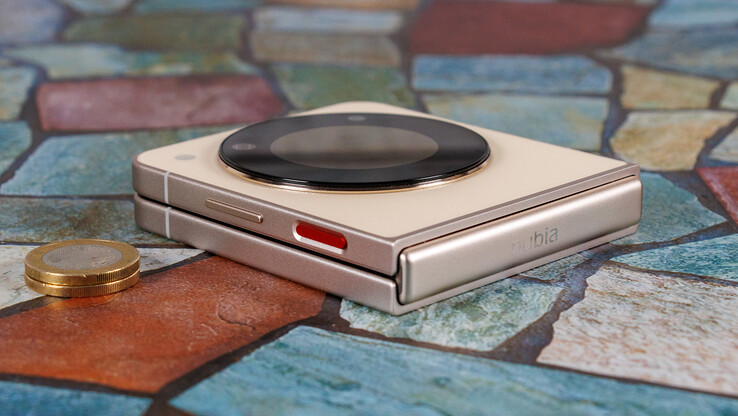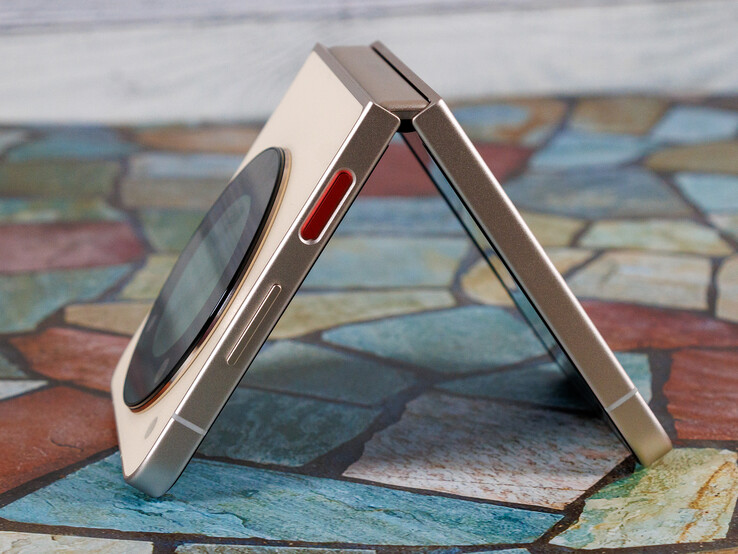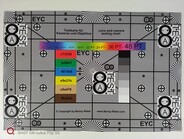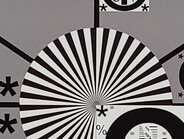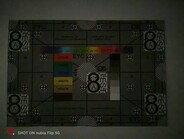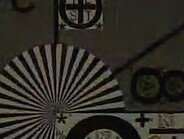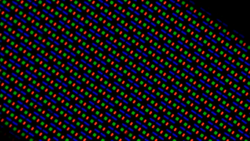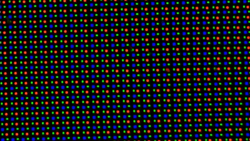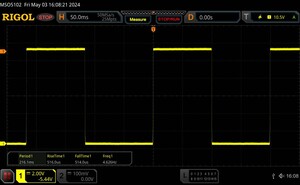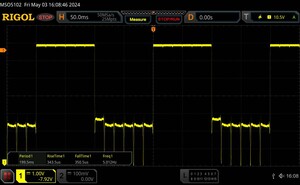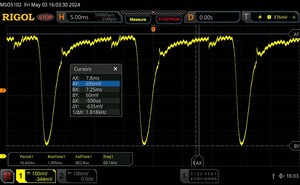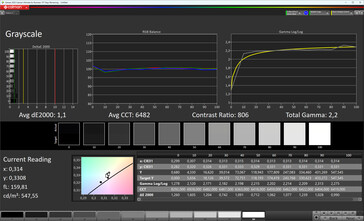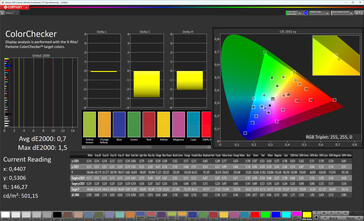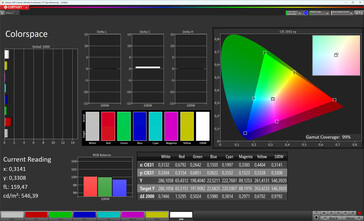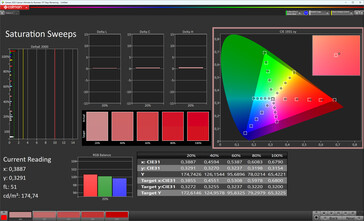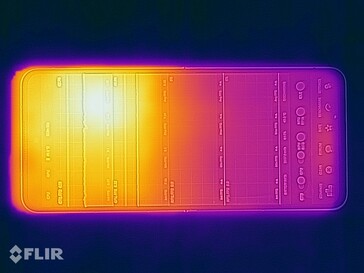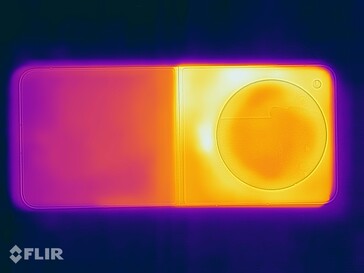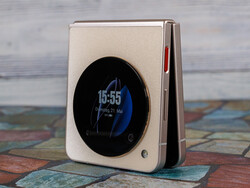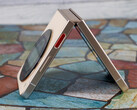Nubia Flip 5G review - The affordable flip phone with a great display
Possible competitors compared
Rating | Date | Model | Weight | Drive | Size | Resolution | Price from |
|---|---|---|---|---|---|---|---|
| 85.4 % v7 (old) | 05 / 2024 | Nubia Flip 5G SD 7 Gen 1, Adreno 644 | 214 g | 256 GB UFS 2.2 Flash | 6.90" | 2790x1188 | |
| 86.3 % v7 (old) | 02 / 2024 | Oppo Find N3 Flip Dimensity 9200, Immortalis-G715 MP11 | 201 g | 256 GB UFS 4.0 Flash | 6.80" | 2520x1080 | |
| 83.3 % v7 (old) | 10 / 2023 | Tecno Phantom V Flip Dimensity 8050, Mali-G77 MP9 | 194 g | 256 GB UFS 3.1 Flash | 6.90" | 2640x1080 | |
| 86.9 % v7 (old) | 08 / 2023 | Samsung Galaxy Z Flip5 5G SD 8 Gen 2 for Galaxy, Adreno 740 | 187 g | 256 GB UFS 4.0 Flash | 6.70" | 2640x1080 | |
| 86.4 % v7 (old) | 07 / 2023 | Motorola Razr 40 SD 7 Gen 1, Adreno 644 | 188.6 g | 256 GB UFS 2.2 Flash | 6.90" | 2640x1080 |
Case and connectivity - The Nubia Flip 5G with a matte aluminum frame
The Nubia Flip 5G is available in the colors Cosmic Black, Flowing Lilac and Sunshine Gold. Buyers can choose between two memory variants: 8 GB RAM with 256 GB storage or 12 GB RAM with 512 GB. Our test device is the gold model.
We like the Nubia Flip's build quality. All gaps are tight and even and its display surface ratio of 86 % is quite good—but much lower than the manufacturer's specification (95.4 %). The hinge is said to withstand more than 200,000 folds and allows a wide range of opening angles. Although the display fold is easy to see and feel, it does not interfere with everyday use. However, the Flip is quite thick and heavy for a foldable smartphone.
Communication, software and operation
The Nubia Flip 5G still comes delivered with Google Android 13, over which the manufacturer has installed its own MyOS 13.5 user interface. It's a bit of a shame that Nubia only offers three years of security patches and one major upgrade. At the time of testing, the latest security patch was dated February 1, 2024 and is therefore no longer completely up-to-date.
Custom backgrounds and an always-on display can be configured for the phone's outer display. Its range of functions includes up to eight widgets: camera, weather, music control, calendar, appointment overview, pedometer, stopwatch and an audio recorder. These can also be deactivated and sorted individually.
A positive is that the device supports Wi-Fi 6E, which is not yet mandatory within this price range. In combination with our reference router, the Asus ROG Rapture GT-AXE11000, the Flip achieves high and stable transmission values. It also covers ample cellular frequencies, and our Nubia foldable didn't face any reception problems during the test. Its call quality is decent as long as the smartphone is held up to your ear—it just doesn't do too good a job at filtering out background noise.
For biometric security, a fingerprint sensor is integrated into the phone's power button, which delivers good recognition rates and unlocks the Flip 5G at a good speed. Unlocking the phone via facial recognition using the cameras is just as reliable, but less secure.
| Networking | |
| Nubia Flip 5G | |
| iperf3 transmit AXE11000 | |
| iperf3 receive AXE11000 | |
| iperf3 transmit AXE11000 6GHz | |
| iperf3 receive AXE11000 6GHz | |
| Oppo Find N3 Flip | |
| iperf3 transmit AXE11000 | |
| iperf3 receive AXE11000 | |
| Tecno Phantom V Flip | |
| iperf3 transmit AXE11000 | |
| iperf3 receive AXE11000 | |
| Samsung Galaxy Z Flip5 5G | |
| iperf3 transmit AXE11000 | |
| iperf3 receive AXE11000 | |
| iperf3 transmit AXE11000 6GHz | |
| iperf3 receive AXE11000 6GHz | |
| Motorola Razr 40 | |
| iperf3 transmit AXE11000 6GHz | |
| iperf3 receive AXE11000 6GHz | |
Cameras - Good photos on the Samsung JN1
The front-facing camera delivers rather average photography performance. Photos appear somewhat pale and are not particularly detailed. Videos can only be recorded in Full HD (30fps).
In turn, the cover display can also be used as a viewfinder for the main camera, which results in better selfies. Operating it via the small panel is quite limited, as it is only possible to switch between photo, portrait and video—but it does serve its purpose.
The main camera uses the Samsung JN1 sensor and produces nice-looking photos. Photos are also impressive in low-light conditions. However, the second lens only provides depth information; the Nubia Flip 5G does not have an ultra-wide angle or optical zoom.
Videos can be recorded in Ultra HD at 30fps or in Full HD at 60fps.
Image comparison
Choose a scene and navigate within the first image. One click changes the position on touchscreens. One click on the zoomed-in image opens the original in a new window. The first image shows the scaled photograph of the test device.
Main cameraMain camera5x zoomLow light

Display - Bright and accurate 120 Hz panel in the Flip 5G
The Nubia Flip 5G's 6.9-inch OLED display can get really bright and it can reach up to 1,193 cd/m² when depicting a pure white display with the ambient light sensor activated. This value was also fairly stable in the APL18 test (1,195 cd/m²) and HDR measurement (1,149 cd/m²). If you adjust its brightness manually, you can expect a maximum of 550 cd/m². Its color and grayscale depiction is very accurate.
According to Nubia, the Flip 5G offers high-frequency PWM dimming at up to 2,160 Hz; we measured 1,818 Hz at minimum display brightness and low-frequency flickering (60 Hz) with a higher amplitude. This is probably Black Frame Insertion (BFI), which is used to reduce motion blur and as burn-in protection. As a result, the flip smartphone should be comparatively easy on the eyes.
| |||||||||||||||||||||||||
Brightness Distribution: 97 %
Center on Battery: 1164 cd/m²
Contrast: ∞:1 (Black: 0 cd/m²)
ΔE ColorChecker Calman: 0.7 | ∀{0.5-29.43 Ø4.78}
ΔE Greyscale Calman: 1.1 | ∀{0.09-98 Ø5}
99% sRGB (Calman 2D)
Gamma: 2.2
CCT: 6482 K
| Nubia Flip 5G OLED, 2790x1188, 6.9" | Oppo Find N3 Flip AMOLED, 2520x1080, 6.8" | Tecno Phantom V Flip AMOLED, 2640x1080, 6.9" | Samsung Galaxy Z Flip5 5G Dynamic AMOLED, 2640x1080, 6.7" | Motorola Razr 40 P-OLED, 2640x1080, 6.9" | |
|---|---|---|---|---|---|
| Response Times | -124% | -52% | -90% | -86% | |
| Response Time Grey 50% / Grey 80% * (ms) | 0.69 ? | 2.13 ? -209% | 1.5 ? -117% | 1.42 ? -106% | 1.7 ? -146% |
| Response Time Black / White * (ms) | 1.03 ? | 1.43 ? -39% | 0.9 ? 13% | 1.78 ? -73% | 1.3 ? -26% |
| PWM Frequency (Hz) | 60 | 120 | 60 | 120 | 180.3 |
| PWM Amplitude * (%) | 21.4 | ||||
| Screen | -7% | -148% | -95% | -29% | |
| Brightness middle (cd/m²) | 1164 | 922 -21% | 822 -29% | 836 -28% | 982 -16% |
| Brightness (cd/m²) | 1172 | 932 -20% | 797 -32% | 848 -28% | 1002 -15% |
| Brightness Distribution (%) | 97 | 96 -1% | 95 -2% | 97 0% | 85 -12% |
| Black Level * (cd/m²) | |||||
| Colorchecker dE 2000 * | 0.7 | 0.7 -0% | 3.5 -400% | 2.6 -271% | 0.93 -33% |
| Colorchecker dE 2000 max. * | 1.5 | 1.8 -20% | 6.6 -340% | 4.5 -200% | 2.52 -68% |
| Greyscale dE 2000 * | 1.1 | 0.9 18% | 2 -82% | 1.6 -45% | 1.4 -27% |
| Gamma | 2.2 100% | 2.24 98% | 2.249 98% | 2.22 99% | 2.188 101% |
| CCT | 6482 100% | 6569 99% | 6815 95% | 6319 103% | 6480 100% |
| Total Average (Program / Settings) | -66% /
-37% | -100% /
-124% | -93% /
-94% | -58% /
-43% |
* ... smaller is better
Display Response Times
| ↔ Response Time Black to White | ||
|---|---|---|
| 1.03 ms ... rise ↗ and fall ↘ combined | ↗ 0.516 ms rise | |
| ↘ 0.514 ms fall | ||
| The screen shows very fast response rates in our tests and should be very well suited for fast-paced gaming. In comparison, all tested devices range from 0.1 (minimum) to 240 (maximum) ms. » 3 % of all devices are better. This means that the measured response time is better than the average of all tested devices (20.2 ms). | ||
| ↔ Response Time 50% Grey to 80% Grey | ||
| 0.69 ms ... rise ↗ and fall ↘ combined | ↗ 0.3435 ms rise | |
| ↘ 0.3505 ms fall | ||
| The screen shows very fast response rates in our tests and should be very well suited for fast-paced gaming. In comparison, all tested devices range from 0.165 (minimum) to 636 (maximum) ms. » 2 % of all devices are better. This means that the measured response time is better than the average of all tested devices (31.6 ms). | ||
Screen Flickering / PWM (Pulse-Width Modulation)
| Screen flickering / PWM detected | 60 Hz Amplitude: 21.4 % | ||
The display backlight flickers at 60 Hz (worst case, e.g., utilizing PWM) . The frequency of 60 Hz is very low, so the flickering may cause eyestrain and headaches after extended use. In comparison: 53 % of all tested devices do not use PWM to dim the display. If PWM was detected, an average of 8111 (minimum: 5 - maximum: 343500) Hz was measured. | |||
Measurement series with fixed zoom level and different brightness settings (The amplitude curve at minimum brightness looks flat, but this is due to the scaling. The info box shows the enlarged version of the amplitude at minimum brightness).
Performance, emissions and battery life
The Nubia Flip 5G is powered by the Snapdragon 7 Gen 1, which is also used in the Razr 40. The performance offered by this processor allows for smooth system operation and it should hold enough in reserve for the update period estimated by Nubia.
Although the Nubia smartphone can get very warm under constant high load, it always remains within a safe range. Even then, the SoC can consistently deliver its full performance.
The two speakers sound quite good at medium volume, but as the volume increases, they echo strongly and sound hollow.
The Nubia Flip's 4,310 mAh battery is comparatively large and gives the device surprisingly good runtimes. The foldable smartphone can be charged at a maximum of 33 watts—a suitable power adapter is included in the scope of delivery. It takes around an hour to charge the battery, and the battery is already 50 % full again after just 20 minutes.
| Nubia Flip 5G | Oppo Find N3 Flip | Tecno Phantom V Flip | Samsung Galaxy Z Flip5 5G | Motorola Razr 40 | Average 256 GB UFS 2.2 Flash | Average of class Smartphone | |
|---|---|---|---|---|---|---|---|
| AndroBench 3-5 | 181% | 40% | 119% | 0% | -11% | 73% | |
| Sequential Read 256KB (MB/s) | 967.4 | 3794 292% | 1814.9 88% | 3412.35 253% | 955.8 -1% | 903 ? -7% | 2216 ? 129% |
| Sequential Write 256KB (MB/s) | 766.69 | 2965 287% | 1490.7 94% | 2289.61 199% | 804.3 5% | 727 ? -5% | 1837 ? 140% |
| Random Read 4KB (MB/s) | 263.87 | 411 56% | 249.9 -5% | 444.6 68% | 290.8 10% | 226 ? -14% | 294 ? 11% |
| Random Write 4KB (MB/s) | 295.55 | 558 89% | 238.9 -19% | 161.87 -45% | 257.5 -13% | 247 ? -16% | 334 ? 13% |
Temperature
(-) The maximum temperature on the upper side is 47.7 °C / 118 F, compared to the average of 35.2 °C / 95 F, ranging from 21.9 to 247 °C for the class Smartphone.
(±) The bottom heats up to a maximum of 43.4 °C / 110 F, compared to the average of 34 °C / 93 F
(+) In idle usage, the average temperature for the upper side is 27.2 °C / 81 F, compared to the device average of 32.9 °C / 91 F.
3DMark Wild Life Stress Test
Speakers
Nubia Flip 5G audio analysis
(+) | speakers can play relatively loud (89.5 dB)
Bass 100 - 315 Hz
(-) | nearly no bass - on average 26.8% lower than median
(±) | linearity of bass is average (7.7% delta to prev. frequency)
Mids 400 - 2000 Hz
(+) | balanced mids - only 4.6% away from median
(+) | mids are linear (4.8% delta to prev. frequency)
Highs 2 - 16 kHz
(±) | higher highs - on average 8.8% higher than median
(+) | highs are linear (6.9% delta to prev. frequency)
Overall 100 - 16.000 Hz
(±) | linearity of overall sound is average (21.9% difference to median)
Compared to same class
» 44% of all tested devices in this class were better, 8% similar, 48% worse
» The best had a delta of 11%, average was 35%, worst was 134%
Compared to all devices tested
» 62% of all tested devices were better, 7% similar, 31% worse
» The best had a delta of 4%, average was 24%, worst was 134%
Samsung Galaxy Z Flip5 5G audio analysis
(+) | speakers can play relatively loud (89.6 dB)
Bass 100 - 315 Hz
(-) | nearly no bass - on average 22.3% lower than median
(±) | linearity of bass is average (9.2% delta to prev. frequency)
Mids 400 - 2000 Hz
(+) | balanced mids - only 4.2% away from median
(+) | mids are linear (3.8% delta to prev. frequency)
Highs 2 - 16 kHz
(±) | higher highs - on average 6.6% higher than median
(+) | highs are linear (3.5% delta to prev. frequency)
Overall 100 - 16.000 Hz
(±) | linearity of overall sound is average (17.3% difference to median)
Compared to same class
» 11% of all tested devices in this class were better, 8% similar, 81% worse
» The best had a delta of 11%, average was 35%, worst was 134%
Compared to all devices tested
» 31% of all tested devices were better, 8% similar, 60% worse
» The best had a delta of 4%, average was 24%, worst was 134%
Runtimes
Pros
Cons
Verdict - The Nubia Flip 5G with gaps in its features
The Nubia Flip 5G has some strong selling points thanks to its long battery life and excellent display. Wi-Fi 6E is still a rarity in this price range and its main camera takes good shots.
The Nubia Flip 5G is a good foldable smartphone but for its price, it is a little too slimmed down at times.
On the other hand, the Flip also has to face some criticism. For example, only a few HDR standards and no eSIMs are supported. We would also have liked to see an additional ultra-wide-angle lens or an optical zoom. Its update period is very short, too.
At US$499 or US$699, its price sounds very attractive at first, but the larger storage version of the Galaxy Z Flip 5 is not that much more expensive—and a Flip 4 is even cheaper. Even the Razr 40 now costs less than US$700.
Price and availability
The Nubia Flip 5G can be purchased directly from the manufacturer's website, with prices starting from US$499.
Nubia Flip 5G
- 06/17/2024 v7 (old)
Daniel Schmidt
Transparency
The selection of devices to be reviewed is made by our editorial team. The test sample was provided to the author as a loan by the manufacturer or retailer for the purpose of this review. The lender had no influence on this review, nor did the manufacturer receive a copy of this review before publication. There was no obligation to publish this review. As an independent media company, Notebookcheck is not subjected to the authority of manufacturers, retailers or publishers.
This is how Notebookcheck is testing
Every year, Notebookcheck independently reviews hundreds of laptops and smartphones using standardized procedures to ensure that all results are comparable. We have continuously developed our test methods for around 20 years and set industry standards in the process. In our test labs, high-quality measuring equipment is utilized by experienced technicians and editors. These tests involve a multi-stage validation process. Our complex rating system is based on hundreds of well-founded measurements and benchmarks, which maintains objectivity. Further information on our test methods can be found here.




